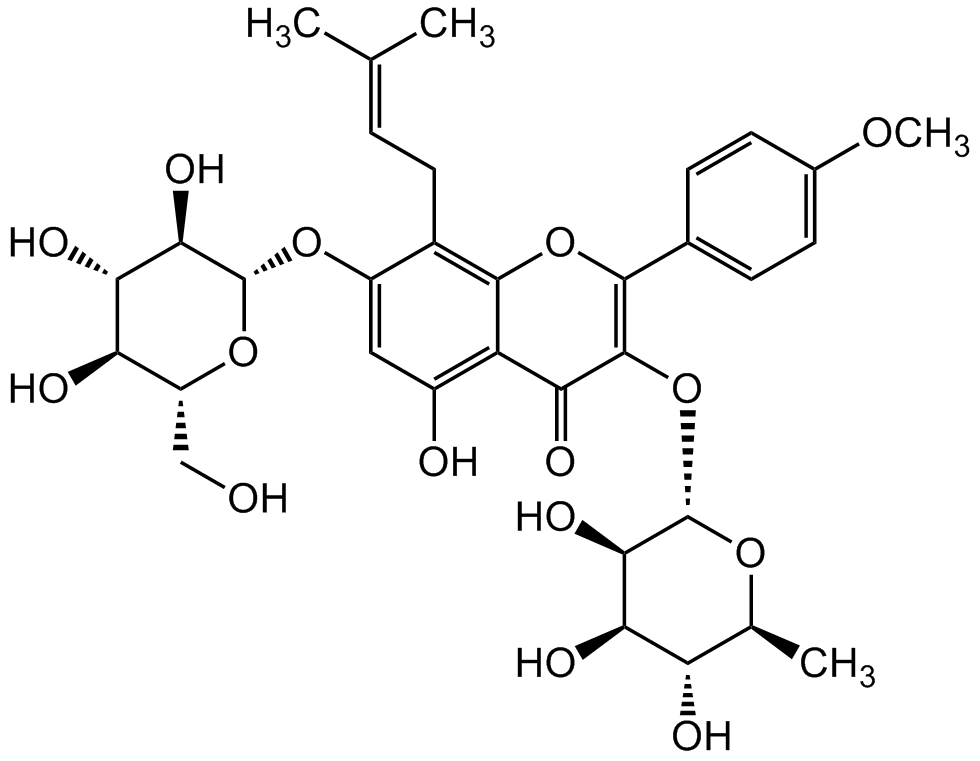Icariin
| Code | Size | Price |
|---|
| CDX-I0172-M100 | 100 mg | £84.00 |
Quantity:
Prices exclude any Taxes / VAT
Overview
Host Type: Plant
Regulatory Status: RUO
Shipping:
AMBIENT
Storage:
Short Term: +20°C Long Term: -20°C
Images
Documents
Further Information
Alternate Names/Synonyms:
4'-O-Methyl-8-gamma,gamma-dimethylallylkaempferol-3-rhamnoside-7-glucoside; Leariline
Appearance:
Light yellow fine powder.
CAS:
489-32-7
EClass:
32160000
Form (Short):
solid
Handling Advice:
Protect from light and oxygen.
InChi:
InChI=1S/C33H40O15/c1-13(2)5-10-17-19(45-33-28(42)26(40)23(37)20(12-34)46-33)11-18(35)21-24(38)31(48-32-27(41)25(39)22(36)14(3)44-32)29(47-30(17)21)15-6-8-16(43-4)9-7-15/h5-9,11,14,20,22-23,25-28,32-37,39-42H,10,12H2,1-4H3/t14-,20+,22-,23+,25+,26-,27+,28+,32-,33+/m0/s1
InChiKey:
TZJALUIVHRYQQB-XLRXWWTNSA-N
Long Description:
Chemical. CAS: 489-32-7. Formula: C33H40O15. MW: 676.668. Icariin, the active component of the Chinese medicinal plant E. brevicornum. It has been shown to have anti-inflammatory, anticancer, antioxidant, osteoprotective, neuroprotective and cardioprotective activity. It has been shown to enhance bone formation and bone regeneration. Icariin may be beneficial to Alzheimer's disease by reducing the production of extracellular amyloid plaques and intracellular neurofibrillary tangles and inhibiting phosphodiesterase-5 activity. The anti-cancer activity is related to various mechanisms such as apoptosis and autophagy induction, cell cycle modulation, antiangiogenesis and antimetastasis, modulating multidrug resistance and immunomodulation. Icariin interacts with several pathways, like PDE, TGF-beta, MAPK, PPAR, NOS, IGF, Sirtuin and others. Icariin has been shown to inhibit the NF-kappa activation pathway and NLRP3 inflammasome.
MDL:
MFCD00210516
Molecular Formula:
C33H40O15
Molecular Weight:
676.668
Package Type:
Vial
Product Description:
Icariin, the active component of the Chinese medicinal plant E. brevicornum. It has been shown to have anti-inflammatory, anticancer, antioxidant, osteoprotective, neuroprotective and cardioprotective activity. It has been shown to enhance bone formation and bone regeneration. Icariin may be beneficial to Alzheimer's disease by reducing the production of extracellular amyloid plaques and intracellular neurofibrillary tangles and inhibiting phosphodiesterase-5 activity. The anti-cancer activity is related to various mechanisms such as apoptosis and autophagy induction, cell cycle modulation, antiangiogenesis and antimetastasis, modulating multidrug resistance and immunomodulation. Icariin interacts with several pathways, like PDE, TGF-beta, MAPK, PPAR, NOS, IGF, Sirtuin and others. Icariin has been shown to inhibit the NF-kappa activation pathway and NLRP3 inflammasome.
Purity:
>97% (HPLC)
SMILES:
O=C1C2=C(O)C=C(O[C@H]3[C@H](O)[C@@H](O)[C@H](O)[C@@H](CO)O3)C(C/C=C(C)/C)=C2OC(C4=CC=C(OC)C=C4)=C1O[C@H]5[C@H](O)[C@H](O)[C@@H](O)[C@H](C)O5
Solubility Chemicals:
Soluble in DMSO (20mg/ml) or DMF (20mg/ml).
Source / Host:
Plant
Transportation:
Non-hazardous
UNSPSC Category:
Natural Products/Extracts
UNSPSC Number:
12352200
Use & Stability:
Stable for at least 2 years after receipt when stored at -20°C.
References
(1) L.G. Ming, et al.; J. Cell Physiol. 228, 513 (2013) (Review) | (2) J.K. Schluesener & H. Schluesener; Mol. Nutr. Food Res. 58, 49 (2014) (Review) | (3) H.L. Tan, et al.; Front. Pharmacol. 7, 191 (2016 (Review) | (4) R. Shen & J.H. Wang; Am. J. Clin. Exp. Immunol. 7, 50 (2018) (Review) | (5) B. Su, et al.; Life Sci. 208, 26 (2018) | (6) J. Jin, et al.; Eur. J. Pharmacol. 842, 20 (2019) (Review) | (7) C. Angeloni, et al.; Front. Pharmacol. 10, 271 (2019) (Review) | (8) A. Yang, et al.; Stem Cells Int. 2019, 5747298 (2019) (Review)



